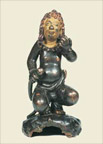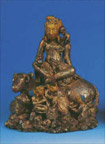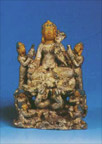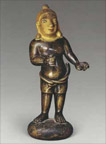The Sculpture of Chöying Dorjé, Tenth Karmapa
by Ian Alsop
text and photos © asianart.com and the author except as where otherwise noted
January 07, 2013
This article was originally published as Chapter 8 of the catalogue published by the Rubin Museum: Karl Debreczeny, (with contributions by Ian A. Alsop, David P. Jackson and Irmgard Mengele) The Black Hat Eccentric : Artistic Visions of the Tenth Karmapa, 2012, Rubin Museum of Art, NY. This online version is the same as that found in the printed version with the exception of a few minor corrections to the text and a few additions to footnotes, as well as addition of detail images. Any updated versions of this article will be clearly so described, and this original version will remain on these pages as is for the record.
(click on the small image for full screen image with captions)
During those times it is certain that many amazing signs occurred, such as beholding the faces of the divine chosen deities, but he did not say to anyone, "It happened like this." Nevertheless, since he created unprecedented images of Tārā in the form of a human girl with an extremely passionate demeanor and of Avalokiteśvara seated upon a cow and holding the stem of a lily, everyone proclaimed that these were from having beheld their faces.
—Biography of Chöying Dorjé recounting events from around 1629 to 1630, before Chöying Dorjé was twenty-six [665Ulrich von Schroeder 2001, Buddhist Sculptures in Tibet: Tibet & China, vol. 2 (Hong Kong: Visual Dharma Publications), 798 and 664n. This passage, translated for von Schroeder by Cyrus Stearns, is from Tsang Khenchen Jamyang Palden Gyatso ('Jam sbyangs dpal ldan rgya mtsho, 1610-1684)'s biography of the Tenth Karmapa. Irmgard Mengele believes that Tsang Khenchen is in fact the Karmapa's faithful companion and attendant, Küntu Sangpo. (see Irmgard Mengele, forthcoming, Riding a Huge Wave of Karma: The Turbulent Life of the Tenth Karma-pa (Kathmandu: Vajra Publications), p. 287-289, "The Karmapa's Attendant Küntu Zangpo"; also, 204, 27n; on the biography, 309-311.]
In Tibet there will be no one better than me in the arts of poetry and painting. I am a person who gladdens Avalokiteśvara. I have come into this world to paint paintings.
—Biography of Chöying Dorjé, when he was forty-nine [666Mengele forthcoming, 234-235, citing the unpublished biography of Chöying Dorjé: this took place in 1653, when Chöying Dorjé was 49 yrs. old. Quoted also in David Jackson, 1996, A History of Tibetan Painting (Vienna: Verlag Der Osterreichischen Akademie der Wissenschaften), 247.]
Yarlung Period or Tenth Karmapa?
In Ulrich von Schroeder's magnificent survey of metal sculpture in Tibet, Buddhist Sculptures in Tibet, he identified a group of ten sculptures as originating from the Yarlung kingdom of the seventh to eighth century, during the time of the Tibetan emperors who introduced Buddhism to Tibet.[667Von Schroeder 2001, 742 ff.; pls. 174-182 attributed to Yarlung. Another 12 sculptures are attributed to West Tibet "Zhang zung" from the same general time period, 768-791, pls. 182-189.] Three of the images of this group are inscribed with attributions to the Tenth Karmapa Chöying Dorjé, (1604–1674), but von Schroeder discounted these inscriptions as much later additions.
It is my opinion that six of the ten sculptures von Schroeder included in the Yarlung group (Figs. 8.1–6) in fact are the work—as the inscriptions on three of them attest—of the eccentric and brilliant seventeenth-century Tibetan high lama and artist, the Tenth Karmapa Chöying Dorjé. I believe that two others of this group (Fig. 8.7 and Fig. 8.8) are either works of Chöying Dorjé or perhaps copies of his work. The first part of this text gives the reasons for this opinion. [668I should emphasize at the beginning of this essay that in the absence of any satisfactory forensic testing for bronze sculpture, my opinion can only be taken for just that. In no way should my opinion be construed as an attack on the work of Ulrich von Schroeder, which I greatly admire. Without his masterful compendiums we would likely not even know of the existence of many of the sculptures in this group. Indeed it was through his painstaking research in Tibet and outside that we have been introduced to the sculptural tradition of Chöying Dorjé. I should also mention his liberality with the images from his work 108 Buddhist Statues in Tibet (London & Chicago: Serindia Publications, 2008) which have been distributed for free download, use and publication on a DVD accompanying the book and also on a website, http://jokhangsculpture.com. I would also like to acknowledge here the help I have received with this article from many colleagues, and specifically from Irmgard Mengele, whose in-depth work on the Life of the Tenth Karmapa has been an invaluable resource. I have also received precious information and help from Jeff Watt, Karl Debreczeny, Amy Heller, Nik Douglas, David Weldon and Ed Hunter, and have benefited greatly from the hard work of the RMA editorial team led by Helen Abbott and Helen Chen, and from the skill and cheerful patience of designer Phil Kovacevich.]
In no way should my opinion be construed as an attack on the work of Ulrich von Schroeder, which I greatly admire. Without his masterful compendiums we would likely not even know of the existence of many of the sculptures in this group; indeed it was largely through his painstaking research in Tibet and elsewhere that Western scholars have become familiar with the complex and fascinating sculptural tradition of Chöying Dorjé. [669Primarily in Ulrich von Schroeder 2001, Buddhist Sculptures in Tibet: Tibet & China, vol. 2 (Hong Kong: Visual Dharma Publications).]
My primary reasons for advancing my opinion are fourfold.
- I believe the inscriptions on three of the sculptures in the first group of six should be taken at face value unless there are overwhelming reasons to dispute what they say.
- The unprecedented and enigmatic iconography of these sculptures is consonant with the work of an eclectic, ecclesiastically high-ranking artist who did not have to follow prescribed iconography but inconsonant with the beginning years of a religious art tradition based on another already established tradition.
- The strong resemblance between the enigmatic figures portrayed in these sculptures and similar figures in many of Chöying Dorjé's paintings, his authorship of which are not in question.
- A differing interpretation of the apparent wear of the sculptures, which I believe can be partially explained from the peculiar circumstances of the Tenth Karmapa's unusually active and peripatetic life.
The Eight Sculptures
The first four images, (Figs. 8.1–4), are cast in a high-copper content alloy: the first three of these are inscribed while the fourth is not. The next two images, (Figs. 8.5 and 8.6), are cast in silver. The final two images, (Figs. 8.7 and 8.8) are also cast in copper, but are not inscribed. While I am fully convinced that the first six images (Figs. 8.1–6) are the work of Chöying Dorjé, I am not so convinced of his authorship of these last two, though they are clearly in his style.
1. Inscriptions
The first three images illustrated above (Figs. 8.1–8.3) are inscribed with nearly identical attributions to the Tenth Karmapa Chöying Dorjé
(a work made by the venerable Chöying Dorjé)
In addition, two of the inscriptions (Figs. 8.1 and 8.3) add the description of the image as byin rlabs rcan (spiritually charged).
(a spiritually charged [statue] made by the venerable Chöying Dorjé)
Three other sculptures have recently come to my attention with very similar inscriptions (Figs. 8.9–8.11).
These last three sculptures are different in many respects from the group we are considering here, but their inscriptions are similar in their wording to the first three inscribed bronzes we have seen (Figs. 8.1–3). We will return to these last three sculptures later.
It is worth noting that sculptures are not the only objects bearing inscriptions attributing the object to the Tenth Karmapa Chöying Dorjé. At least three paintings are also inscribed with attributions to this artist; in two cases with wording similar to the inscriptions on these sculptures. [678I know of at least three paintings with inscriptions: 1) A painting of Marpa in the Ulrich and Heidi von Schroeder collection (fig. 0.5 in this catalogue) with the inscription: "This image of Marpa the translator is a spiritually charged painting [by] the venerable Chos dbying rdo rje that he gave to his intimate disciple Kun tu bzang po, " from Karl Debreczeny 2003, "The Buddha's Law Among the 'Jang: The 10th Karmapa's Development of his 'Chinese-Style Thangka Painting' in the Kingdom of Lijiang," Orientations 34, no. 4 (April 2003): 48, fig 4, and von Schroeder 2001, 807, fig. XII-23; 2) the first in a group of Sakyamuni and the 16 arhat paintings from the Lijiang Dongba Cultural Museum in Debreczeny 2003, 49, fig. 8a, with an inscription for the prince of Lijiang (fig. 3.1 in this catalogue); and 3) a painting of a Protector, in a private collection (Figs. 0.3 and 6.7 in this catalogue) with the inscription: "This painting by the Venerable Chos dbying rdo rje, an image of the great long-haired one (ral can skyes bu chen po) who punishes enemies of the [Buddhist] Doctrine and eradicates evil, was made in the sheep year in the place mGur ru shar la of Mi nyag, in accordance with the request of his intimate disciple Kun tu bzang po." In Jackson 1996, 254.]
Von Schroeder, in referring to one of the inscriptions found on Figs. 8.1, 8.2, and 8.3, writes, "There can be absolutely no doubt that the inscription referring to the Tenth Karmapa Chöying Dorjé (1604–1674) was added in the seventeenth century at the earliest." [679"There can be absolutely no doubt that the inscription referring to the Tenth Karmapa Chos dbyings rdo rje (1604-1674) was added in the 17th century at the earliest. The same inscription is written on the pedestals of two other early copper images (Pls. 174 & 175). It appears that the inscriptions on all three images were engraved at the same time. However, the technical characteristics such as the heavy casting and the strong fire gilding, as well as the worn appearance due to worship, point to a much earlier time, presumably the Tibetan imperial period (Yar lung dynasty, c. 600-842)." From von Schroeder 2001, 756; see also 752, 754.] In this we are in full agreement of course. Where we disagree is in the actual date of manufacture of the sculptures themselves, which I believe were indeed made by the Tenth Karmapa, as the inscriptions attest.
While my main reasons for believing they are the work of this prolific and eccentric artist are their unprecedented iconography, their extraordinary cohesiveness as a group, and their strong resemblance to other works by this artist, we should certainly also examine the issue of the inscriptions themselves.
In von Schroeder's discussion of the genuineness of the attribution to Chöying Dorjé in these inscriptions, he asks the question his theory so clearly begs, and ventures a possible answer, "The crucial question is: who added the inscriptions to these Yarlung copper statues? Perhaps someone who was familiar with Chöying Dorjé's distinctive work mistakenly added the inscriptions to the ancient images because of their iconographic and stylistic similarities." [680Von Schroeder 2001, 806.] While this scenario may be the only reasonable one that can be ventured, I do not believe this is how these inscriptions came about.
In my experience with inscriptions of works of art from the Himalayas, I have never run across an inscription that I felt was intended to inaccurately portray when or by whom the object was made, unless it was clearly a modern attempt to deceive the market as a fake. [681Of course there are attempts to forge inscriptions on modern copies. These are usually rather easily found out as almost invariably there are mistakes in orthography and awkward engraving.] There are occasions when the replacement for a destroyed or damaged object is inscribed with a copy of the inscription from the original object; however, this is invariably accompanied by an inscription describing the repair/replacement and reconsecration of the object.[682A good example is the copy, now in Bharat Kala Bhavan, Varanasi, India, of the remarkable painting of Vanaratna in the Los Angeles County Museum of Art. The original, dated 1469, is quite damaged, and a copy (now in Bharat Kala Bhavan) contains a copy of the original inscription as well as an inscription describing the circumstances of the copy. See Dr. Pratapaditya Pal 1985, Art of Nepal (California: University of California Press, 1985), 136-137, also discussed in Dr. Pratapaditya Pal 1978, The Arts of Nepal:Part II, Painting (Innerasien, Vol 3, No 2) (Leiden/Köln: Brill), 22-23.]
In considering these six inscriptions we should note that they are unusual in the Tibetan context in that they mention only who made the image, and no other information is given. Most Tibetan inscriptions on icons deal specifically with the circumstances of the consecration and dedication of the sacred image, describing details of who ordered the image to be made and for what purpose.[683Amy Heller has described the normal relationship between inscription and consecration, remarking: "The inscription may be conceived as an aspect of the consecration ceremony, whether or not that is formally stated in the inscription, as such a ceremony punctuates the act of creation. Had the inscription been afterwards as a re-consecration, the initial phase would in principle be noted, for such an omission would be tantamount to negating the previous consecration." Amy Heller 1995, "Buddhist Images and Rock Inscriptions from Eastern Tibet, VIIIth to Xth Century, Part IV," in Tibetan Studies: Proceedings of the 7th Seminar of the International Association for Tibetan Studies, Graz 1995, vol. 1, ed. Helmut Krasser, et al. (Vienna: Verlag der Osterreichischen Akademie der Wissenschaften, 1997), 386.] As von Schroeder notes in his descriptions of Figures. 8.1–3, and 8.8 [684Von Schroeder 2001, 750, 754, 756, 758.] there is no evidence that any of them were ever consecrated in the standard Tibetan style by filling them with religious objects and sealing the bottom with a plate. In the more standard consecration inscriptions, it is rare—though not unknown—to have any information regarding the artist who made the object. And inscriptions as terse as the six we have encountered here are uncommon.[685Later we will touch briefly upon another interesting group of sculptures with very brief inscriptions that merely identify a person, in this case the group of some 15 now known sculptures from Kashmir and West Tibet with the name "na ga ra dza" inscribed upon them. See below in this article, and note 689 below.]
If we accept that these inscriptions were added to the sculptures near the time when they were made by the Tenth Karmapa Chöying Dorjé, as I believe, then the question still arises: Who actually wrote the text of these inscriptions and engraved them, or caused them to be engraved, on the sculptures? Were these inscriptions added to the sculptures at the time they were made or at some later date?

Fig. 8.9[690I would like to thank Jeff Watt for bringing this image to my attention and for his generous and unfailing help with my work on the subject of the sculpture of Chöying Dorjé. He brought not only this image to my attention but also several others (figs.8.11, 8.19, 8.35).]The orthography of several of these six inscriptions is similar in many respects, which might lead us to speculate that several of the inscriptions may have been written/inscribed by the same hand. This is particularly true of the two standing bodhisattvas in Chinese style (Figs. 8.9 and 8.10). The wording of the inscriptions is remarkably close for all six inscriptions, with a slight variation in the case of the silver Ninth Karmapa.[686We can note a minor spelling difference: the "rje" in "rdo rje" is shown only by the convention of a horizontal diacritic over the "rdo" in two inscriptions (Figs. 8.9 and 8.11) whereas it is fully spelled out in all the others. The last inscription, found on the image of the Ninth Karmapa, is different from all the others in referring to Chos dbying rdo rje as ka rma rather than rje btsun at the beginning of the inscription, (and also in the reference to the subject of the sculpture following the attribution) but is otherwise the same.]

Fig. 8.10Since they are not consecration inscriptions, they refer to no actual event other than the manufacture by Chöying Dorjé. While it is my belief that they faithfully represent the fact that Chöying Dorjé made the sculptures they adorn, even if we accept them as truthful, we cannot be certain how they came to be inscribed. Were they inscribed thus by the Karmapa himself or on his orders? Or were they perhaps inscribed on someone else's instructions? Karl Debreczeny presents one inscribed painting that he thinks may have been inscribed by the Karmapa himself because of the restrained and nonhonorific language. (Fig. 3.1a) [687Whereas all the other known inscriptions refer to the Karmapa as "rje btsun", "venerable", an honorific term for high lamas and saintly figures, this inscription refers to him as "the one practiced in the arts called 'Lokeshvara', the one praised as the 10th to be blessed with the name 'Karmapa'." Debreczeny remarks, "The modest phrasing used to the 10th Karma-pa here, 'praised as the tenth one blessed with the name "Karmapa" ' suggests that the inscription was indeed written by Chos dbyings rdo rje himself." Debreczeny 2003, 49. See also this catalogue Fig. 3.1, and pp 97 ff.] The inscriptions on the sculptures, however, bear honorific phrases, and in two cases refer to the sculptures as "spiritually charged" images, from which we might infer that the inscriptions were arranged by someone other than the Karmapa. Nevertheless, we cannot rule out that the Karmapa himself had them inscribed; if the Karmapa instructed someone to inscribe the images with an attribution to him as the artist, without specifying the wording, it would be natural for honorifics to be used.[688We should also note that modesty does not necessarily mark the Karmapa's own references to himself. Even in the Karmapa's own autobiographies, he is hardly modest, referring to himself as "the bodhisattva" and "Leader of the World ('jig rten rnam par 'dren pa). (See below in this article and Mengele (forthcoming), 238; from Chos dbying rdo rje Big Drum 742.4 – 743.5). High incarnations may have very humble views of themselves as persons or monks, but also understand that honorifics must be used when addressed them as lineage holders.]
I feel it is possible, perhaps even likely, that these inscriptions represent an attempt by someone—either the Karmapa or someone else, perhaps after his death—to inventory works by the Tenth Karmapa by adding these terse inscriptions. Like the equally terse inscriptions added to two other groups of Tibetan works of religious art, a group of sculptures inscribed with the name Naga Raja and the group of Onpo Lama Rinpoche thangkas,[689The Naga Raja sculptures most likely refer to the "Lama/King" or "royal monk" of that name from West Tibet (988-1026) who was the son of the great ruler/monk Ye she 'od (947-1024). A large group of sculptures exist that are inscribed with variations of his name and title, most of these give little other information. The inscriptions on at least two of these sculptures read, "lha btsun pa na ga ra dza'i thugs dam", "personal image of Lha btsun Naga Raja". The phrase "thugs dam", implies that the image is that of the chosen deity or "yidam" of the monk-king (in both cases the images are of a standing Buddha). For the first of these two images, the famous Cleveland Museum standing Buddha ( 66.30, Purchase John L. Severance Fund) see von Schroeder 1981, Indo-Tibetan Bronzes (Hong Kong: Visual Dharma Publications), 122, pl. 18E; Dr. Pratapaditya Pal 1975, Bronzes of Kashmir (New Delhi/Graz: Munshiram Manoharlal), 100, pl. 26; and David Weldon 2011, "Two Bronzes from the Western Himalayas Revisited," Orientations 42-5 (June 2011), 67, fig. 1, and numerous other publications, also at http:// www.clevelandart.org/collections/collection%20 online.aspx?pid={91ADCD8F-992A-45A5-8599- 70835467DF5E}&coid=5821540&clabel=hig hlights; For the second, a spectacular standing Buddha in the Lima Lhakhang of the Potala in Lhasa, see Ulrich von Schroeder, Buddhist Sculptures in Tibet vol. I, India and Nepal (Hong Kong: Visual Dharma Publications, 2001), 126-129, pl. 28; Pratapaditya Pal, 2008, The Arts of Kashmir (New York: 5Continents, Asia Society), 61, Fig. 45; David Weldon 2011, "Two Bronzes from the Western Himalayas Revisited," Orientations 42-5 (June 2011): 68, fig. 3, and http://jokhangsculpture.com/gallery1/3b.html. This second example also bears an ancient Kashmiri inscription, making it clear that Naga raja could not have commissioned it (see von Schroeder 2001, vol. I p. 126ff.). See also Amy Heller 1999, Tibetan Art ( Milan: Jaca), 62, pl. 33.
A group of thangkas from the Karma Kagyü Taklung school are found with an inscription, usually across the top of the back, indicating that they had been consecrated by Onpo Lama Rimpoche, the fourth abbot of Taklung who moved a branch of the monastery to a new location, Riwoche in Eastern Tibet. In both cases the inscriptions are found on a relatively diverse group of objects some of which are clearly earlier than the time of the personality whose name is found upon them. But of course in neither this case nor in the case of the Naga raja sculptures is the name found in the inscriptions attributed with actually making the object, as is the case with the Chöying Dorjé group. These notes on a portrait of a Taglung lama can be found in several places: See Jane Singer 1995, Notes on a Taklung Portrait (March 17, 1995) http://asianart.com/singer/singer.html, and Jeff Watt 2001, "Teacher (Lama) - Taklung Tangpa Chenpo," HAR no. 89957, http://www.himalayanart. org/image.cfm/89957/alt/89957A.html; (April 2001) "There is an inscription and blessing sanctification on the back of the painting attributed to Onpo Rinpoche. These dedications are currently dated to circa 1272."] these inscriptions seem clearly an attempt to include these inscribed images in a specific group.
Chöying Dorjé's consciousness of style and quality is mentioned throughout his biographies. Like many artists, he was also a collector of sorts. The Karmapa and his faithful companion Küntu Sangpo had a large collection of statues when they were living in the later years of the Karmapa's life in exile in Gyalthang in far eastern Tibet. In 1658 when he was fifty-four years old, he wrote of his life in exile and described two of his own creations:

Fig. 8.11[691I would like to thank Jeff Watt for bringing this image to my attention.]
At that time, in the pure and remote forest of Mount Potala, not too far from the hermitage in which the Lord of the World ('jig rten dbang phyug) [Tenth Karmapa] stayed in solitude, [there was] the very lovely dwelling place of Kun tu bzang po, a small house with several floors. It contained a Sugata [Buddha] statue, very beautifully constructed, with many of the characteristic forms (bkod pa) used by Kashmiri artisans. [The statue] was dressed in various silken clothes, fine, soft and light, with all the qualities of a god's garment. [Kun tu bzang po's house also contained] a statue of Avalokiteśvara, a cubit (skyes bu'i khru gang ba), made from the white sandalwood of Mount Malaya. [These two images] were made by me, the trained artisan, the Leader of the World ('jig rten rnam par 'dren pa), as an object of prostration.
The Karmapa went on to describe the other contents of the shrine of his faithful servantlama Küntu Sangpo:
Furthermore, [Kun tu bzang po's shrine also contained] all kinds of gods from central Tibet, Nepal, and from eastern and western India—innumerable objects of prostration for the people. [There were also] countless books from the vast collection of teachings of the Buddha and from the sections [on learning concerned with] biographical narratives and poetry. To all of these objects of prostration for the people and to the stupas that held the core of the relics, [we] the two Bodhisattvas [the Tenth Karmapa and Küntu Sangpo] from time to time offered flowers, sprinkled oblation water, permeated [the holy objects] with sandalwood incense, and offered fruits and food with very delicious taste and excellent nutrition.[692Mengele (forthcoming), 238; from Chos dbying rdo rje Big Drum 742.4 – 743.5.]This passage makes clear that the Karmapa and Küntu Sangpo managed a large collection of sculptures from all over the Buddhist world, including objects made by the Karmapa himself. The earlier passage notes the Karmapa's interest in, and devotion to, Kashmiri models in sculpture, which is clearly reflected in one stylistic theme prevalent among his own sculptures. These passages also emphasize the aesthetic principles that, for the Karmapa, went hand in hand with the religious importance of these "objects of prostration."
It is not surprising that an artist so attuned to these objects would desire to inventory those he made himself. If the inventory was not the Karmapa's idea, one wonders if it might not have been Küntu Sangpo who was responsible for the inscriptions on the Tenth Karmapa sculptures. His devotion to the Karmapa is one of the overriding features of the biographies of Chöying Dorjé, especially his autobiographies. Küntu Sangpo was clearly very much involved with recording the events of the Tenth Karmapa's life.[693As we've mentioned before, Irmgard Mengele believes Küntu Sangpo is none other than the learned cleric Tsang Khenchen, who wrote an important biography of the Karmapa. See Mengele (forthcoming) pp. 287-289, "The Karmapa's Attendant Küntu Zangpo"; also, p. 204, n. 27; on the biography, pp. 309-311.] It would seem plausible that it might have been Küntu Sangpo who initiated the inscribing of sculptures with this brief inscription ascribing them to the hand of Chöying Dorjé. No one knew his master and his master's creations better than this learned lama, who was the recipient of many gifts of sculpture and painting from the Karmapa.
Could it be that Küntu Sangpo might have made a mistake after his master's death and inscribed the attribution erroneously on sculptures that the Karmapa had collected and carried with him but did not make? As we have seen, von Schroeder raised just such a possibility when he wrote, "Perhaps someone who was familiar with Chöying Dorjé's distinctive work mistakenly added the inscriptions to the ancient images because of their iconographic and stylistic similarities."[694See von Schroeder 2001, 806.]
Such a mistake is theoretically possible but, considering the closeness of these two men and their long experience together, unlikely. If these Yarlung sculptures were in the Karmapa's possession, surely he and his close associate would have viewed them and remarked on them often enough for Küntu Sangpo to be aware of their actual origins and to avoid mislabeling them as the work of the Karmapa.[695Von Schroeder also writes, "It can be assumed that the Yar lung copper statues copied by Chos dbyings rdo rje (1604 –1674) were in the Jo khang / gTsug lag khang at Lhasa during his lifetime," in von Schroeder 2001, 800. This would mean the erroneous attribution would have been inscribed on the statues while they were in the Jokhang collection.]
2. Unprecedented and Enigmatic Iconography
The deities depicted in the six sculptures of this first group are unusual and difficult to identify. This complexity can be seen in the identifications of some of these figures essayed by Ulrich von Schroeder. He identifies Figure 8.1 as "Composite Image with Aspects of Agni, Yama, Kubera and Hayagriva,"[696Von Schroeder 2001, 750, pl. 174.] again as "the enigmatic composite image incorporating aspects of Agni, Kubera, Nagaraja and Yama,"[697Von Schroeder 2001, 814.] and later as "Yama with aspects of Kubera and Hayagriva."[698Von Schroeder 2008, 108, pl. 30.] Figure 8.2, which he describes as the "oldest Tibetan metal sculpture," and "from the iconographical point of view…by far the most interesting,"[699Von Schroeder 2001, 743.] he identifies as "Composite Image with Aspects of Vajrapani, Kubera, and Possibly Hayagriva."[700Von Schroeder 2001, 754, pl. 175.] Figure 8.3 is a "Composite Image with Aspects of Hayagriva and Yama"[701Von Schroeder 2001, 756, pl. 176.] or "Hayagriva—the 'Horse-Necked One.' "[702Von Schroeder 2008, 110, pl. 31B.] The two silver images appear to be simpler in identification, as von Schroeder identifies them as "Sarasvatī"[703Von Schroeder 2001, 762-763, pl. 179.] (Fig. 8.6) and "Avalokiteśvara"[704Von Schroeder 2001, 764-765, pl. 180.] (Fig. 8.5). Figure 8.4 von Schroeder identified in 2001 only as "Unidentified Male Deity Seated on a Cow,"[705Von Schroeder 2001, 766-767, pl. 181.] which is in my opinion his most concise identification in this iconographically perplexing group. In 2008, however, he changed his identification of this figure to "Yama—the 'Lord of Death,'" and changed the mount to a "horned bull buffalo."[706Von Schroeder 2008, 110, pl. 31A.] Figures 8.7 and 8.8 are more simply cataloged: the first as "Hayagriva" and the other as "Sarasvatī," but even these identifications are not immediately clear.
In describing the group of ten sculptures he identifies as Yarlung, von Schroeder wrote:
The sculptures cast during the imperial period illustrated in this publication should remove the last doubt about the existence of accomplished native Tibetan artists by at least the eighth century. But the question remains of how the Tibetans learned to master the wax modeling of deities and to overcome the technical obstacles connected with the casting process. The only places where the Tibetans could have learned how to cast images would have been Nepal or India, unless they obtained the necessary knowledge by assisting Newār and Indian craftsmen working in Tibet. One should not regard these statues as the products of isolated workshops, because the Tibetan craftsmen certainly were in contact with Newār and Indian artists and had seen images made by them.[707Von Schroeder 2001, 742.]
Von Schroeder acknowledges that Tibetan sculptors must have learned from Nepalese and Indian artists either by going to India or Nepal or by learning from Indian or Nepalese artists working in Tibet, of which there were quite a few. But von Schroeder's scenario assumes that while they may have learned the techniques of lost-wax casting from Indians or Nepalese, these early Tibetan sculptors felt little obligation or inclination to follow the iconographic program of their Indian and Nepalese teachers. Rather they launched themselves into extraordinary iconographic experiments never seen before and never seen since until they ostensibly formed models for Chöying Dorjé nearly a thousand years later. Von Schroeder describes the forces that he judges were responsible for this iconographic experimentation:
The copper images discussed here show that during the early stages of Buddhist propagation in Central Tibet, the Tibetans did not merely copy Indian or Nepalese Buddhist deities. On the contrary, the composite character of these early Tibetan sculptures somehow manifests the struggle between the indigenous tradition and the Indian Buddhist and Brahmanical influences. The iconographic development demonstrated by these early sculptures reflects the process of assimilation and adaptation of the traditional religious values.[708Von Schroeder 2001, 742-743.]
This scenario certainly leads us to several important questions. Who were the teachers who supplied the sadhanas and darshanas (texts describing the appearance of a deity) of these extraordinary composite deities, or did the early Tibetan sculptors just make them up themselves? Are there any textual references to these extraordinary composites; any sadhanas that describe them?[709See von Schroeder 2001, 743 for further suggestions regarding the milieu in which these creations occurred.]
Von Schroeder quotes an interesting passage of just such visions by the young Chöying Dorjé:
Furthermore, during those times it is certain that many amazing signs occurred, such as beholding the faces of the divine chosen deities, but he did not say to anyone, "It happened like this." Nevertheless, since he created unprecedented images of Tārā in the form of a human girl with an extremely passionate demeanor and of Avalokiteśvara seated upon a cow and holding the stem of a lily, everyone proclaimed that these were from having beheld their faces.[711Von Schroeder, 2001, 798 and 664n.]
In examining the first group of six images (Figs. 8.1–6) "unprecedented" certainly applies to the iconographic program they display, which defies clear-cut definition. "Avalokiteśvara seated upon a cow and holding the stem of a lily" surely could remind us of the wonderful sculpture (Fig. 8.4) showing a relaxed male figure reclining, holding the stem of a flower, on the back of an unusual cow,
[712As we shall see, von Schroeder relates this vision to another sculpture, our fig. 8.1 and the copies made from it.] while the Tārā of "passionate demeanor" might possibly be related to either Figure 8.8 or Figure 8.17
Aside from the six figures that we have dealt with here, there are two other sculptures (Figs. 8.7 and 8.8) in von Schroeder's Yarlung group that exhibit several of the characteristics of the Chöying Dorjé style, and for this reason I believe they cannot be Yarlung period. One is a small male figure (Fig. 8.7), perhaps Hayagriva, standing on a simple circular base much like those of Figures 8.1–4, and the other is a diminutive sculpture of a seated goddess (Fig. 8.8). The small hands, hair with buns, overall facial characteristics, and the plain circular stand of Figure 8.7 are typical of Chöying Dorjé's style as found in the previous group of six sculptures and also in his paintings. Because of their simplicity and also because several almost exactly similar sculptures exist of at least one of these (Fig. 8.8), which we will examine below, I do not feel we can know for sure whether these are original works of the Tenth Karmapa or copies of his work; but their stylistic origins certainly belong with this enigmatic artist.
3. The Strong Resemblance between These Images and Paintings Made by Chöying Dorjé
Strange and unusual depictions of deities and religious figures—and beings of all kinds—in Chöying Dorjé's work are not limited to these eight remarkable sculptures. His works are unusual not only in their unprecedented iconographic depiction of the deities but also in their unique and unprecedented style or styles.[713"…we should also not forget that Chos-dbyingsrdo- rje worked in more than one style." Jackson, 1996, 256.] But in all the works that we can connect directly to him, we can see certain common threads.
Before we begin our examination of the similarities between these six sculptures and the thangkas painted by the Tenth Karmapa, we will note an emphatic coherence easily recognized within the group of bronzes. Three of the six sculptures (Figs. 8.1, 8.4, and 8.5) depict figures seated on a cow, a rather unusual vehicle in any circumstance, particularly a cow with clearly downturned horns, which is not only highly unusual among Buddhist iconography but also quite unusual among cows.[714Von Schroeder first identifies the animal in fig. 8.1 as a ram, (von Schroeder 2001, 750, pl. 174A-E), then later as a buffalo (von Schroeder 2008, 108, pl. 30). Indeed it is not always possible to identify the animal precisely, but the dewlap would suggest a cow; as would the fact that a later copy clearly interprets the animal as a cow (fig. 8.30). The animal of fig. 8.4 he first identified as a cow, complete with udder (von Schroeder 2001, 766-767, pl. 181A-D) but later as a "horned bull buffalo" (von Schroeder 2008, 110, pl. 31A and http://jokhangsculpture.com/gallery1/31a.html)] We should not be surprised to find yet another cow-borne god in another sculpture, this one in clay, and again with downturned horns (Fig. 8.18), surely another sculpture by the Tenth Karmapa, which is discussed below. Furthermore, the cows in two of the sculptures are shown contentedly chewing on a goodly mouthful of food (Figs 8.1 and 8.4), while the third has her calf with her to keep her company (Fig. 8.5). [715Karl Debrezceny perceptively points out the many depictions of food and eating the paintings of Chöying Dorjé. Debreczeny 2003, 50-51.] These are iconographical details I have never encountered in any other Himalayan Buddhist sculpture.[716Von Schroeder explained the presence of the cow in fig. 8.4: "The inclusion of the cow reflects a regard for the importance of cattle in the pastoral and nomadic Tibetan societies. One of the reasons for the successful spread of Buddhism was its ability to assimilate existing local traditions as an instrument of consolidation." von Schroeder 2001, 766.]
All the figures (Figs. 8.1–8) share many traits: six of the eight are shown on more or less simple circular or ovoid bases, whether standing (Figs. 8.2, 8.3, and 8.7) or seated (Figs. 8.1, 8.4, and 8.5,); all have similar facial expressions—tiny mouths and arched eyebrows in pudgy, long faces with voluminous chins. All have piled-up tresses of curly hair (Figs. 8.1–3) or hair knotted into a large bun at the back or side (Figs. 8.4, 8.6, 8.7, and 8.8).
Von Schroeder also appreciates the stylistic coherence of these sculptures, for he assigns the first three sculptures of the group (Figs. 8.1–3) to "the same anonymous Tibetan artist of the Tibetan imperial period."[717Von Schroeder 2001, 744.] Remarkably, the three sculptures he sees as made by the same anonymous Yarlung artist are the three with inscriptions attributing them to Chöying Dorjé. On this point we are in agreement, that all three are the work of the same artist.
The two silver figures are unusual for their crowded composition. The silver Sarasvatī (Fig. 8.6) is the only figure depicted seated on a lotus, normally standard composition for a deity in Tibetan sculpture; but the rest of the composition and the composition of the silver Avalokiteśvara (Fig. 8.5) are otherwise unusual for the dense crowd of attending figures. The Sarasvatī has two attending figures holding vases on either side and in front features two intertwined nāgas in gestures of adoration and four other figures with various vessels or possibly musical instruments. The Avalokiteśvara features the aforesaid cow and calf, a female figure seated with a drum, and two figures who seem to be approaching with offerings; the first, dressed in robes, leaning down to touch his head to the god's foot may well represent Chöying Dorjé. The tradition that most frequently used compositions with numerous subsidiary figures is that of Kashmir, which Chöying Dorjé admired and was influenced by. A good example of this type of assemblage in the art of Kashmir is the Buddha with Adorants in the Norton Simon Museum (Fig. 8.26). [718See also Pal 1975, 106, pl. 30a.b Gautama Buddha with caityas.; pl. 22a, b, Gautama Buddha with retinue, Norton Simon collection (Fig. 8.26 and Fig. 10.1 in this catalogue).] The two silver sculptures (Figs. 8.5 and 8.6) also share an unusual unfinished surface and overall poor casting, which might suggest an experiment with casting in silver on the part of Chöying Dorjé.
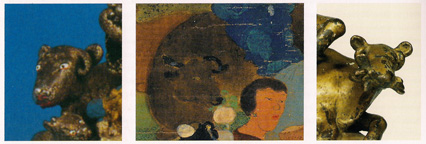
Fig. 8.12It is worthwhile to compare some of the visual elements shared by these sculptures with details of paintings by the Tenth Karmapa. We have already noted that this group of eight sculptures features three cows and a calf, so we are not surprised to see at least one cow and many other animals liberally distributed in the paintings by this master. The cow I noticed in Chöying Dorjé's paintings is lying down behind the master Marpa in the lovely painting in the von Schroeder collection (Fig. 0.5, p. 24) depicting Milarepa being received by Marpa—it is not surprising to see that this cow's horns are also turned down (Fig. 8.12). Karl Debreczeny notes the Karmapa's fascination with animals and also his "emphasis on food and eating," pointing out all the eating going on in this Marpa painting.[719Debreczeny 2003, 46; 50-51.] So the cows chewing on their grass in the two copper sculptures (Figs. 8.1 and 8.4) should not surprise us. The portrayal of the kneeling cow in the painting of Marpa is very similar to the cow with her calf in the silver Avalokiteśvara (Fig. 8.5, detail) as well as the cow in the reclining figure holding the stem of a flower (Fig. 8.4, detail).
Similarly remarkable are the physical features of the figures portrayed in the Karmapa's paintings, whether god or human. These striking physical characteristics can easily be listed: small hands; round, elongated faces with tiny mouths set above expansive chins; arched eyebrows; and unusual hairstyles often featuring buns or cascades of curls.[720Debreczeny 2003, 46, notes: "The attributed paintings all share a whimsical style that is immediately recognizable by the small abbreviated faces with tiny pursed red lips floating in the center of elongated heads." See also Pratapaditya Pal, Himalayas: An Aesthetic Adventure (California: University of California Press, 2003), where Pal notes the "strong individualism that makes him perhaps the most original master known in the history of Tibetan Art" p. 264.] These same characteristics can be observed in the eight sculptures (Figs. 8.1–8).
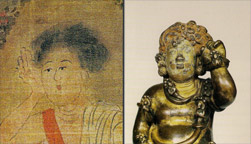 Fig. 8.13 |
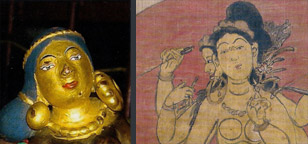 Fig. 8.14 |
The accompanying images here show some of the whimsical attributes shared by the paintings and sculptures. Compare the face of the composite figure seated frontally on a cow (Fig. 8.1, detail) with the face of Milarepa in the Bordier painting (Fig. 8.13). Both share the round face with tiny mouth, the arched eyebrows, and the mass of unruly hair, while the upraised hands in both appear comparably stubby and juvenile. Compare the face of the silver Sarasvatī (Fig. 8.6) or that of the seated Tārā (Fig. 8.8, detail) with the face of the painted Marici (Fig. 8.14). We can see similar facial characteristics, jewelry, and hairstyles. Note the similarity in proportion and gesture in the details of Figure 8.3 and the scroll holder in the Peaceful Wind arhat painting (Fig. 8.15). The robed figure bowing to the silver Avalokiteśvara (Fig. 8.5), perhaps Chöying Dorjé, can be compared with the kneeling hunter in the Karmapa's vivid painting of Milarepa in his cave (Fig. 8.16).
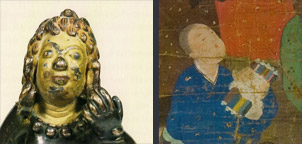 Fig. 8.15 |
 Fig. 8.16 |
4. Technique and Condition
Von Schroeder's primary evidence for discounting the inscribed attributions to Chöying Dorjé and assigning these sculptures to the Yarlung period is from an assessment of physical attributes: "The technical characteristics such as the heavy casting and the strong fire gilding, as well as the worn appearance due to worship, point to a much earlier time, presumably the Tibetan imperial period, (Yarlung dynasty, ca. 600–842)."[721Von Schroeder 2001, 756.] This set of criteria— heavy casting, strong fire gilding, and worn appearance—is repeated several times in his description of each of the three sculptures that bear the inscribed attribution to Chöying Dorjé.[722See further citations: von Schroeder 2001, 752, 754, 756; von Schroeder 2008, 108, 110. In 2008, von Schroeder addressed this issue at some length: "On the front side of the pedestal is a single-line inscription in dBu can script attributing this statue to the Tenth Karmapa Chos dbyings rdo rje (1604 – 1674). There can be absolutely no doubt that the inscription on this and another statue was added in the 17th century at the earliest (Plate 31B) . The stylistic and technical characteristics, such as the unusually heavy casting and the worn surface, point to a much earlier period. However, it was this statue that inspired the Karmapa, who must have seen it during one of his visits to the Jo khang to create a somewhat similar object (Pl 32A). It remains a mystery, who and why this inscription was added to a statue, which already in the 17th century, was clearly recognizable as an ancient image. In this context it should be pointed out that none of the metal statues cast by Chos dbyings rdo rje appear to have been manipulated to look old. From this follows that the intention of the Karmapa was not to create "ancient statues" but simply to create works of art with ancient stylistic features. This explains why it is absolutely impossible that Chos dbyings rdo rje himself created this statue." von Schroeder, 2008, 108. Regarding manipulation to create an antique look, see below and also note 731.]
Von Schroeder is not alone in assigning an early date to these sculptures. The figure in his family collection (Fig. 8.2) was published three times before it entered the von Schroeder collection and in all three instances, it was assigned to the seventh to ninth century and described as Nepalese.[723This figure was also published in 1) Oriental Art (n.s.) Vol. 33, No. 2, 1987, in an advertisement by Adrian Maynard, described as: "Bronze figure of Kubera; Nepalese, 6/7th c.": 2) Sotheby's New York, 1993 Indian and Southeast Asian Art, 17 June 1993, lot. No. 4; Nepalese Bronze figure of Vajrapani, Licchavi, circa 7/8th century; and 3) Sotheby's New York, 1994 Indian and Southeast Asian Art, 30 November 1994, lot 235: "Nepalese Bronze Figure of Vajrapani, Licchavi, ca. 8th c.".] The Nepalese attribution is natural in the case of "heavy casting, strong fire gilding" and, additionally a very high copper content. This type of casting and finishing was and still is a specialty of the Newar sculptors of the Kathmandu Valley. Von Schroeder himself examines the Nepalese connection when he describes his "Yarlung" group: "The copper statues with remains of gilt can be regarded as examples of the traditions existing in Central Tibet, possibly in the Lhasa and the Yarlung areas (Pls. 174-182—includes our Figs. 8.1-8.8). Nepalese influence can be detected not only with regard to gilt copper as the preferred medium but also in style matters."[724Von Schroeder 2001, p. 742.] He surmises that one of his "Yarlung" group (Fig. 8.8) and the other copies of the same image (Figs. 8.32 and 8.33), "are all more or less faithful renditions of a particularly famous image, probably of Nepalese origin."[725Von Schroeder 2001, p. 760.] While the gilt copper medium can certainly be associated with Nepalese sculpture from that period (7th/8th centuries) it can also be seen later as well in both Tibet and Nepal.
Many instances of heavy casting and strong fire gilding in Tibetan works of the seventeenth century certainly exist aside from these works by the Tenth Karmapa.[726See for instance von Schroeder 1981, Plates 120A-125G, pp. 444–55.] The well known and prolific fifteenth-century and later material from Densatil Monastery confirms that these characteristics are not exclusive to very early periods.
Nor should we be surprised that Chöying Dorjé produced sculpture with a pronounced Nepalese feel. It's possible that he may have had some of his sculpture cast by hired craftsmen, and, if those casters were Nepalese, it would be natural that they would work with a high copper content alloy embellished with gilding.[727The separation of the stages of sculpting and casting is the norm in many lost-wax sculpture traditions – including the modern Western tradition. In today's Nepalese tradition, in which copper is still the dominant metal for fine works, the sculptor will usually work directly in wax in the sculpting stage (in the West the norm is clay); and sometimes the sculptor will also take charge of casting; but in some cases, the sculpture will be sold uncast (normally with the clay investment mold already applied), and the new owner continues the process towards the finished sculpture. It would not be at all surprising if, as a metal sculptor, Chöying Dorjé limited himself to sculpting in wax, and left the casting to others. The evident miscasting of the two silver sculptures (Figs. 8.5 and 8.6) might indicate that Chöying Dorjé attempted the casting himself, for such miscasting is typical of the work of neophytes. For descriptions of the image casting tradition in the Kathmandu Valley of modern Nepal, see Ian Alsop and Jill Charlton 1973, "Image Casting in Oku Bahal", Contributions to Nepalese Studies, INAS Journal Vol. 1, No. 1 (Dec. 1973): 22-49; and , Marie-Laure de Labriffe 1973, "Etude de la Fabrications d'une Statue au Nepal", Kailash, Vol. 1, No,. 3, (1973): 185- 192.] His biography records his hiring of a large group of Nepalese craftsmen to build the reliquary temple for his beloved teacher the Sixth Shamar Rimpoche; this was about the same time when he experienced the visions of the gods and goddesses that I believe may have been the impetus for several of the extraordinary sculptures we see in Figures. 8.1-6. [728Chöying Dorjé called on Nepalese artists to spend three years building a seven-story, silver reliquary for his teacher the Sixth Shamar's relics in Tsurphu, in 1630, when he was twenty-six years old. Mengele forthcoming, p. 165. For the visions, which likely occurred ca. 1629-1630, see Ulrich von Schroeder, Buddhist Sculptures in Tibet vol. II, Tibet & China (Hong Kong: Visual Dharma Publications, 2001), 798 and 664n.]
Regarding the worn appearance of the eight sculptures we are examining here, I agree with von Schroeder that these sculptures — especially the first six of the eight (Figs. 8.1-6) appear worn, and thus, appear old.
Present-day Tibetans take care not to expose their religious images to undue wear. Tibetan sacred sculptures nowadays are often dressed in fine brocades, and worshiped without any physical contact; von Schroeder assigns the beginning of this kind of treatment to shortly before the time of the Tenth Karmapa.[729Von Schroeder writes: "it can be taken for granted that most Tibetan statues that have acquired a highly polished surface with rounded features as a result of ritual handling cannot have been made later than the 13th or 14th centuries. In Tibet the daily ritual handling came to an end sometime during the 15th or 16th century as a result of gilding the faces of the images with painted "cold gold" (Tib.: Grang gser)." von Schroeder 2008, 22. For another interesting discussion of the role of wear in Himalayan sculpture, see David Weldon 2011, 67-68.] While ritual practices in the two cultures are often not in accord, it is worth noting that in the neighboring culture of Nepal, seventeenth-century sculpture can exhibit considerable wear, as the Newar rituals of worship involve anointing, applying of pastes, and touching and scrubbing. It is a truism with considerable validity that judging the age of a Himalayan sculpture by its surface condition is much less reliable than documentary evidence (such as inscriptions) or stylistic analysis. Different sculptures have lived different lives and their condition reflects that.
Is it possible that Chöying Dorjé consciously imitated an ancient appearance in some of the sculptures he made? In discussing Figure 8.1, which he believes is the ancient model for some of Chöying Dorjé's works, von Schroeder denies this possibility, writing,
None of the metal statues cast by Chöying Dorjé appear to have been manipulated to look old. From this follows that the intention of the Karmapa was not to create "ancient statues," but simply to create works of art with ancient stylistic features. This explains why it is absolutely impossible that Chöying Dorjé himself created this statue"[730Von Schroeder 2008, 108.]
Of course von Schroeder, when he speaks of metal statues cast by Chöying Dorjé, is not referring to the statues inscribed with his name, Figure 8.1 among them—which he assigns to the Yarlung period. David Weldon has pointed out in several articles the existence of a tradition in Tibet of "manufactured wear," "an effect of age that was manufactured at the sculpture's inception, presumably to replicate wear observed on old statues that had lost their gilding through extensive handling" most noticeably achieved by selective application of the gilding. He sees just this type of wear in Figure 8.1, the Avalokiteśvara seated on a cow, and takes this as a clear sign that the sculpture has been manufactured to deliberately mimic an ancient patina. As he writes in describing another sculpture, the surface "exhibits considerable loss of gilding, an effect of age that was manufactured at the sculpture's inception, presumably to replicate wear observed on old statues that had lost their gilding through extensive handling." In the case of Figure 1, this "loss" of gilding does appear artificial, as Weldon describes.[731Weldon has written several articles touching on this subject. See "Tibetan Sculpture Inspired by Earlier Foreign Sculptural Styles", Oriental Art, n.s., Vol. 46 No. 2, (2000): 47-56., where he describes a Tibetan gilt copper sculpture of Maitreya which "exhibits considerable loss of gilding, an effect of age that was manufactured at the sculpture's inception, presumably to replicate wear observed on old statues that had lost their gilding through extensive handling ." See also, Weldon, 2002, "Tibetan Sculpture Inspired by Earlier Foreign Sculptural Styles." Tibet Journal, Vol. XXVII No 1 &2, (Spring/Summer 2002): pp. 3-36.
From a forthcoming article, Weldon describes the "manufactured wear" apparent on Fig. 8.1: "One of the most prominent parts of the statue is the platform on which the feet rest, where the gilding remains undisturbed on its upper section. This is incongruous with normal wear patterns from handling, where the gilding on the foot support would be among the first areas to wear through to the copper beneath. The unconvincing pattern runs in similar fashion throughout the bronze. The wear to the knee area leaves the gilding on the shins neatly intact while the gilt loss extends implausibly to the back of the calves. The protruding left leg of the recumbent cow retains gilding on precisely the area where it would be most handled, and likewise the tail. An isolated patch of gilding remains on the beast's left cheek with gilt loss all around it, including beneath the gilt patch that is virtually inaccessible to handling. And so on. The gilding of an ancient bronze does not wear away in such unlikely patterns. This is a classic case of manufactured wear and tear to create the effect of antiquity. It is likely that the composite iconography and the manufactured effects of age have been combined to create a notion of antiquity in homage to the long lost and inspired roots of Tibetan Buddhism. Indeed it is more than likely that most of the works in von Schroeder's chapter on the metal sculptures of the Yarlung dynasty, pls 174A-182E, are inventions of a later era (with the obvious exception of the Chinese Vajrapani, 182A, and the seated Buddha 182C) and made during the revivalist period of the late sixteenth through the nineteenth century. Three of these statues are inscribed and name the Tenth Karmapa, Choying Dorje (1604-1674) as the sculptor, which could explain their anomalies of iconography and style: Choying Dorje was known for his appreciation of antiquities and his playful take on early artistic traditions".] This raises the possibility that Chöying Dorjé did in fact consciously create surfaces on some of his sculptures that imitated ancient patinas.
We must also take into account that Chöying Dorjé's life was an unusual one, and if we imagine that he likely carried many of the works he made with him in his entourage, we can assume that these sculptures were often subjected to rather harsh conditions, conditions that were shared by their creator. Several times in his life, the Tenth Karmapa was forced to flee advancing hostile forces. The most famous, of course, was when in 1645 at the age of forty-one, he miraculously escaped the army of the Fifth Dalai Lama's patron, the Gushri Khan, when that army leveled his encampment in the southern Tibetan district of Lhodrak. Alone, save for his faithful Küntu Sangpo, Chöying Dorjé wandered for more than a year and eventually made his way to Gyalthang in southwestern Kham and Lijiang in Yunnan where he lived in exile for some twenty-five years.[732Mengele forthcoming, 192 ff.]
A description in one of his autobiographies, Big Drum, of flight from an army of invaders while staying in Gyalthang nearly thirteen years later, is indicative of the perilous condition of the Karmapa's personal safety throughout much of his life:
Then, when spring had come, one day in the afternoon, a repulsive, hunchbacked creature with dark skin came walking up to us in haste and spoke with the voice of a crow desiring for food, "All the towns and villages of Lijiang have been conquered by an army of barbarians, and they are now coming along the highway on this side of the Yangtse river. There is no doubt that they will definitely also take this place. Now, search for a road to take!" As soon as he had finished saying that, all the villagers ran away in every direction. After Küntu Sangpo had witnessed that, he said to me, "These barbarous people of lowest class do not know [how to distinguish between right] and wrong action.
[Küntu Sangpo asked,] "Now that all the villagers have run to the forest, like wild animals seeing a hunter, since now there is nobody left, in which direction shall we go?" [I] Jikten Nampar Drenpa ('Jig rten rnam par 'dren pa) said, "One of the Eight Fears is the fear of barbarous robbers. Instead of staying near any danger, one should go far away, stay far away from it [and] be cautious." Having said so, I took a [bag] like the skin bag (rkyal ba) of a mongoose belonging to the Yaksha Kubera filled with jewels under my left arm, carried the Kashmiri statue of a deity on my back, and rode on horseback to a solitary place. Before long the Chinese troops dispersed in flight. Then the Karmapa went to Khöltse (Khol tse) hermitage.[733Mengele forthcoming, 242-243.]
This vision of the Tenth Karmapa, here at the age of fifty-four, riding posthaste away from an invading army with a Kashmiri statue on his back is perhaps emblematic of the extraordinary life, at once contemplative and artistic, dangerous and chaotic, of this fascinating man. I would imagine that there were many times when more than one sacred metal image was tumbled into a saddlebag without the benefit of bubblewrap and so rescued from bandits or hostile forces. It is clear from their condition that some of this artist's paintings also suffered from a fair amount of mishandling and stress. So we should not be too surprised by the worn condition of the Karmapa's works, particularly those we can surmise were made when he was young, before his numerous escapes.
In concluding my remarks on the group of sculptures von Schroeder describes as Yarlung, I offer my opinion that six of the ten sculptures he shows were made by Chöying Dorjé, as inscriptions on three of them attest (Figs. 8.1-6); and, in the case of two others of the ten sculptures (Figs. 8.7 and 8.8), were either made by Chöying Dorjé himself, made by an atelier he oversaw, or are later copies of his work.
Leaving this opinion in the hands of the reader, we can now turn to other sculptures that have been associated with the work of the Tenth Karmapa.

Fig. 8.17Since von Schroeder wrote his magnum opus of Tibetan Buddhist sculpture, one other "enigmatic" and "unprecedented" sculpture in metal has come to light that matches many of the characteristics of the Chöying Dorjé style we've seen in Figures. 8.1-8, and that I believe was also made by this master. And yet another sculpture, this one in clay, adds to the variety of his oeuvre.[733AUlrich von Schroeder, in a review of this article, corrected the material from clay to sandalwood.]
An intriguing figure of a simply adorned goddess (Fig. 8.17) is found in the National Museum of Bhutan.[734Bartholomew and Johnston eds., 2008, 147, pl. 1: "Seated Goddess, possibly Kongtsedemo: 7th-8th century".] The Chöying Dorjé characteristics are all in evidence, especially the ovoid face with large chin, arched eyebrows, unusual hairstyle featuring a bun, and asymmetrical earrings. Certainly we should include this sculpture in the oeuvre of Chöying Dorjé. The patina is a glossy-black color, so it is difficult to know the metal, but it would appear to be more of a brassy alloy than the high-copper alloy of the first figures we have examined.[735It seems there is a brass repair of the inner part of the right leg and the skirt.] One wonders again if this is not perhaps the "Tārā in the form of a human girl with an extremely passionate demeanor" mentioned in Tsang Khenchen's biography of the Karmapa. Her posture, relaxed and open legged, might well be interpreted as expressing a "passionate demeanor," although another possibility would be the diminutive Sarasvatī/Tārā of Mindröling, (Fig. 8.8), which shares some of the same attributes of this remarkable sculpture.

Fig. 8.18We have briefly touched on yet another sculpture, in clay[733AUlrich von Schroeder, in a review of this article, corrected the material from clay to sandalwood.], which may be one mentioned in a biography of Chöying Dorjé. The squat and pudgy figure, alas missing his left arm, is seated on a lotus resting on the back of a cow with a short snout and downturned horns (Fig. 8.18). Black in color, he sports the outsize-bead necklace one notices on other related sculptures and a thatch of curly hair on his head; in his right hand he holds a vajra. The familiar facial features—arched eyebrows, tiny pouting mouth in a pudgy face, and mass of curly hair—assure us that this is yet another sculpture by Chöying Dorjé.[736Ulrich von Schroeder has corrected my identification of the material of this sculpture to wood, rather than clay. I originally thought this might be a sculpture described in the Tenth Karmapa's biography: "On the thirteenth day of the first month of the Tibetan New Year 1645 [February 8, 1645], the pair fled to sManthang bZhugs-'tsher in northern hlo-brag, where they stayed for seven days. During this short stay, the Karma-pa made for his loyal attendant a statue of Vajrapani from a mixture of herbs and clay (sman ['dam gyi] sku)." Mengele forthcoming, 193-194. Also in Mengele's list of sculptures, no 15, 1645, A statue of Vajrapani, made of clay mixed with fragrant herbs, for Kun-tu-bzang-po (phyag rdor gyi sman sku)", 385.]

Fig. 8.19Another sculpture has recently come to light that exhibits several characteristics of the Chöying Dorjé style (Fig. 8.19). Clearly a portrait of a Karmapa, perhaps even a self-portrait of the Tenth Karmapa, the figure is cast in a high-copper-content alloy with the main figure appearing to be hollow cast on a square base featuring two lions. The figure of a Karmapa shows several unusual features. He is depicted holding a jar of some kind in his left hand while his right hand holds what appears to be a lotus bud up above his right shoulder, and his bare foot peeks out from his robe just above the rim of the base. It is worth noting that the positions of the hands are very similar to those of the two inscribed Sui dynasty-style standing Avalokiteśvaras (Figs. 8.9 and 8.10). The background aureole, which is a cast addition to the main figure, is very similar to two wooden sculptures we will examine below, featuring an ornate foliate background surmounted by a kind of bower with two birds (we will see this bower with two birds repeated in other sculptures as well). The treatment of this background aureole and those in the two wooden sculptures below (Figs. 8.20 and 8.21) can be compared with the background of buddha figures in several paintings. These include the painting of the Buddha in the Alain Bordier Foundation Collection (Fig. 6.1) and in two other sets of paintings by the Tenth Karmapa, the Śakyamuni with the Sixteen Arhats set from Lijiang (Fig. 3.1) and the set of the events of the life of the Buddha (Fig. 5.8) preserved in Palpung Monastery.[737Buddha Śakyamuni, Alain Bordier Foundation ABP 6 (fig. 6.1 in this catalogue). Previously published: Jackson 1996, 253, pl. 47; von Schroeder 2001, 811, fig. XII-25; Ulrich and Heidi von Schroeder 2009, Tibetan Art of the Alain Bordier Foundation (Hong Kong: Visual Dharma Publications), 49, pl. 18; and the Buddha Sakyamuni from a set of Śakyamuni and the Sixteen Arhats, published Debreczeny 2003, fig. 8, and above in this catalogue, fig. 3.1.] The identification of this sculpture as a self-portrait is supported by similarities with the portrayal of the Karmapa in the first of the Lijiang set of arhat paintings (Fig. 3.1). There he is also shown holding a jug in his left hand and a flower in his right, though the position of the right hand is different—and more conventional—in the painting as compared with this sculpture.
We have already remarked on the differences between the sculptures in our first group (Figs. 8.1-8), of which three are inscribed, and the other three inscribed sculptures presently known to us (Figs. 8.9-11). Where the first group presents truly enigmatic and unprecedented portrayals of visionary deities, the other three inscribed sculptures (Figs. 8.9-11) seem somewhat prosaic by comparison. Two (Figs. 8.9 and 8.10) are almost the same, in the style of early Chinese Buddhist sculpture and are perhaps patterned after a specific model. Depicted is a figure of a standing bodhisattva holding a flywhisk in his right hand and a flask in his left. The general stance and dress is typical of figures from the Sui dynasty (6th-7th century). Figure 8.9 is of slightly better quality and finish than Figure 8.10, although the latter has the added detail of inlaid silver eyes.[738Jin Shen 2002 "Chinese traces reflected on early Tibetan Statues", in Essays on the International Conference on Tibetan Archeology and Art, ed Huo Wei, (Chengdu: Sichuan Remin Chubanshe, 2004): 230-244, 236, Fig. 8.]
Figure 8.11 is a very small (9 cm high) portrayal of the Ninth Karmapa, Chöying Dorjé's predecessor. The treatment of the face has a recognizably Tenth Karmapa oddness to it, with a somewhat comical smile and protruding ears, but, apart from that, the sculpture is not particularly exceptional.
Why are these three sculptures so different from the first group of eight? The Ninth Karmapa sculpture is easily understood as a small portrait of Chöying Dorjé's predecessor. But what are we to make of the other two sculptures, clearly derivative of an early Chinese style of sculpture? And why are there two almost identical figures of Chinese style, standing bodhisattvas with Chöying Dorjé inscriptions?
It is possible that these two images were made when Chöying Dorjé was in exile in Gyalthang and Lijiang, perhaps at the request of a personage from this kingdom. As Karl Debreczeny has shown,[739Debreczeny 2003, 47-48, Fig. 6.] the ruling family of Lijiang was strongly influenced by mainstream Ming culture; the family had adopted the dress and style of the powerful Han courts of central China, and it is certainly possible that they would have preferred the Chinese style in Buddhist statuary as well and prevailed upon the Karmapa to use that style. Or is this perhaps an instance of Chöying Dorjé's copying a well-known image? He often did this according to his biographies, and it was an established practice in Tibetan art. [740There are numerous references to Chöying Dorjé making copies of paintings and also sculptures in biographical sources. See Mengele forthcoming, 130, 140, 171, 172, n.56, 178 , etc. For copies in Tibetan art, see Ian Alsop 1990, "Phagpa Lokeshvara of the Potala," Orientations (April 1990): 51-61, and Ian Alsop 2000, "Copies in Tibetan Sacred Art, Two Examples," Oriental Art, n.s. 46(2) (2000): 4-13.]
I believe that the Tenth Karmapa's art changed through the various periods of his life. From the biographical sources we perceive that his younger years—when he was largely unschooled and perhaps less aware of the strictures of standardized iconography and the weight of previous traditions—may have been a period of visionary creativity. The visions that his biographer ascribed to him occurred before he was twenty-six years old, and it may be that his most liberated sculptures—those seen in Figures. 8.1-6 especially—were done then, while in later years some of his production would appear almost conventional in comparison. Of course, until we know more about the evolution of his art, this must remain conjecture.
Von Schroeder has examined at some length other sculptures that he believes are the works of Chöying Dorjé: among these are several sculptures in media other than metal. Von Schroeder has published two sculptures in wood and four in ivory that he attributes to Chöying Dorjé.
The two sculptures in wood (Figs. 8.20 and 8.21) exhibit striking similarities. Both depict standing bodhisattvas wearing diaphanous robes featuring the distinctive jewelry and upper, shawl-like garment of a specific style of Kashmiri sculpture.[741See Pal 1975, 106, pl. 30a.b Gautama Buddha with caityas, which shows the striated robe and the odd shawl like garment, which is also seen in pl. 29 and pl. 32 in the same volume.] A floral arrangement in the background aureole (inhabited by celestial musicians in the larger example) culminates in a kind of bouquet with intertwined birds. The lotuses are very similar and reminiscent of the style of Kashmir and Swat Valley. The smaller of the two ( Fig. 8.20 ) has a buddha in his headdress, while the larger (Fig. 8.21) has two kneeling attendant figures holding vases at either side. [742Von Schroeder 2001, 805, fig. XII-22 suggests that the smaller image may have been inspired by the oft-copied Phags pa Lokesvara of the Potala. See Alsop 1990.] The carving and style of the figures bears many of the hallmarks of Chöying Dorjé's work, including, above all, the elongated, small-featured faces and small, pudgy hands and feet. The treatment of the background mandorlas are reminiscent of the similarly densely crowded mandorlas encountered in the copper Karmapa portrait (Fig. 8.19) and in several of his paintings (Figs. 6.1 and 6.2). [743Buddha Sakyamuni, Alain Bordier Foundation ABP 6 (fig. 6.1 in this catalogue): Previously published: Jackson 1996, 253, pl. 47; von Schroeder 2001, 811, fig. XII-25; Ulrich and Heidi von Schroeder 2009, Tibetan Art of the Alain Bordier Foundation (Hong Kong: Visual Dharma Publications), 49, pl. 18; the Buddha Sakyamuni from a set of Sakyamuni and the Sixteen Arhats, published Debreczeny 2003, fig. 8, and in this catalogue, fig. 3.1; and the Buddha from the Palpung set, Fig. 5.8 in this catalogue.] These two wood sculptures seem clearly to be by the hand of the Tenth Karmapa.
 Fig. 8.20 |
 Fig. 8.21 |
 Fig. 8.22 |
 Fig. 8.23 |
 Fig. 8.24 |
 Fig. 8.25 |
There are four sculptures in ivory that share many of the Chöying Dorjé stylistic markers in much the same way as the two wooden figures (Figs. 8.22-25). Two of the ivory sculptures are miniature ivory steles featuring events from the Buddha's story (Figs. 8.22 and 8.23). Both are extraordinary tours de force of miniature narrative and detail, packed with figures and animals in every position. The Chöying Dorjé whimsicality is everywhere in evidence, and they must be considered as part of his oeuvre. It is interesting to note that the two compositions, almost identical in size, differ in the treatment of the central Buddha—Indo- Kashmiri style in one (Fig. 8.22) and Tibeto-Chinese in the other (Fig. 8.23).
The other two ivory sculptures (Figs. 8.24 and 8.25), although showing two different postures, resemble each other in almost all stylistic details. Von Schroeder quotes an interesting passage from a Chöying Dorjé biography that mentions that in 1658, when he was fifty-four, he made "two figures of Avalokiteśvara in ivory," which von Schroeder believes are these two.[744Von Schroeder 2001, 802 n685.] Both figures, the one standing, the other seated on an animal (now damaged but likely a cow), are adorned with the skin of an antelope over the left shoulder, which allows us to identify them both as Avalokiteśvara. And like the two wooden figures, we see once more the elongated, fleshy faces so typical of the Tenth Karmapa's work, as well as the extravagant jewelry and dress that seem to be modeled on early Indian styles of the northwest, particularly Swat and Kashmir. A Chöying Dorjé style attribution for these images is certainly warranted on these grounds, but they appear to have also been subject to later copying, which we will investigate below.
The Influence of Kashmir
If there was one clear stylistic influence on the sculpture of Chöying Dorjé, it was that of the art of Kashmir, which he is frequently shown to have admired in biographies and autobiographies. [745See Mengele forthcoming, 99, 240-241.] This influence is evident in these two ivory sculptures, as well as the wooden bodhisattvas we examined above (Figs. 8.20 and 8.21). It is worth taking a look at a few examples of Kashmiri metal sculpture (Figs. 8.26-29) to compare them with elements of some of the sculptures that were made by Chöying Dorjé or clearly in his style.
In each of these four sculptures in the style of art from northwestern India, we can see elements that reappear in many of Chöying Dorjé's sculptures. We have already noticed the "adorant" crowd (Fig. 8.26), which can be compared with the attendant figures found in the two Chöying Dorjé silver sculptures of Avalokiteśvara and Sarasvatī (Figs. 8.5 and 8.6). Like the Kashmiri Buddha, the Sarasvatī is flanked by two attending figures, while a crowd of other figures populates the lower areas of the base. The various animals—lions and deer— crowding the rock formations at the bottom of the base of the Kashmiri sculpture (Fig. 8.26) can be compared with the similar group in the base of the larger of Chöying Dorjé's wooden standing figures (Fig. 8.21).
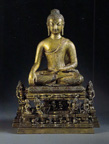 Fig. 8.26 |
 Fig. 8.27 |
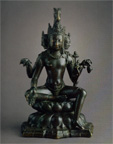 Fig. 8.28 |
 Fig. 8.29 |
The bull on which Parvati[746Jeff Watt notes: "Parvati, the consort of Shiva is one identification for this sculpture, however it is more likely to be Shiva (with a long a at the end of the spelled name) the female form of the god Shiva.
As Parvati she is the daughter of the god Himavat (Himalaya), wife of the god Shiva, mother of the elephant-headed Ganesha and Kumara Kartika; in her fearsome form she is Kali, Durga and power itself - Shakti." http://www.himalayanart.org/image.cfm?icode=65427.] (Fig. 8.27) is seated can be compared with the seated cows that appear in several of Chöying Dorjé's sculptures (Figs. 8.1, 8.4, and 8.5). Of note as well are her simple bead necklace and beaded circular earrings and anklets, so similar to those found in the figure of a seated goddess (Fig. 8.8) and the copies of this figure (Figs. 8.32-34), which we will examine below.
Figure 8.28, perhaps from the region of Swat, also exhibits the simple bead necklace we see on Figures 8.3 and 8.8. In addition, we note here the typical Swat-Kashmir double lotus base, which seems to have formed the model for several Chöying Dorjé sculptures or adaptations (Figs. 8.20 and 8.24). We will see this type of base in several sculptures that may be copies of Chöying Dorjé's work (Figs. 8.30, 8.35-37) which we will examine later.
The simple beaded necklace appears again in Figure 8.29, and in this sculpture we also see the striated treatment of the robe (also found in Fig. 8.27) that can be seen again and again in Chöying Dorjé sculptures, including the seated goddess (Fig. 8.8), the wooden standing figures (Figs. 8.20 and 8.21), and the two ivory figures of Avalokiteśvara (Figs. 8.24 and 8.25), as well as in the bronze figures that appear to have been modeled on these two, which we will examine below.
Originals and Copies: What is a copy of what?
The issue of what is a copy of what? is central to the investigation of the work of Chöying Dorjé. Where von Schroeder believes that Chöying Dorjé copied several sculptures that were originally made in the Yarlung period of the seventh to eighth century, citing specifically two examples (see below), I have argued that the sculptures von Schroeder believes are Yarlung are actually the work of Chöying Dorjé, as the three inscriptions found among them attest.
What then to make of the sculptures that von Schroeder believes to be Chöying Dorjé's copies of one of these very sculptures? Are they indeed also by Chöying Dorjé, or are they perhaps later copies of the original Chöying Dorjé sculptures? Let us start by examining several sculptures that von Schroeder assigns to Chöying Dorjé that he considers copies of two of the sculptures from his Yarlung group. These include the two ivory sculptures (Figs. 8.24 and 8.25), as well as two bronzes that mimic these two ivory sculptures almost exactly (Figs. 8.30 and 8.31) We will review them here with the Yarlung images that von Schroeder considered as possible models for the Chöying Dorjé copies. First we will look at two sculptures von Schroeder considers to be modeled on Figure 8.1, the "enigmatic composite image" seated on a cow.
In describing a bronze sculpture (Fig. 8.30) that almost exactly mimics the ivory Avalokiteśvara (Fig. 8.24), von Schroeder wrote, "The Potala palace Avalokiteśvara (Fig. 8.30) was probably influenced by the enigmatic composite image incorporating aspects of Agni, Kubera, Nagaraja, and Yama in the custody of the Jokhang (Pl. 174A–C)" (our Fig. 8.1).[747Von Schroeder 2001, 814.] In 2008, he also wrote, "This very unusual composition of Avalokiteśvara (Tib. sPyan ras gzigs) seated on a cow is the outcome of a vision by Chöying Dorjé and mentioned in one of his biographies. This might have been after one of his visits to the Jokhang."[748Von Schroeder 2008, 112.] Here the vision mentioned in a biography has been combined with a visit to the Jokhang and a viewing of the "Yarlung" images there, the most important influence being our Figure 8.1. Von Schroeder also mentions the clear similarity to the ivory figure from The Metropolitan Museum of Art (Fig. 8.24), and describes both the ivory and the bronze (Fig. 8.30) as Chöying Dorjé's copies of the Yarlung sculpture (Fig. 8.1), although he does not address the issue of which copy came first.[749Von Schroeder 2001, 798 & 800; also 814]
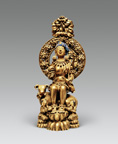
Fig. 8.30It seems logical that both the ivory (Fig. 8.24) and the bronze (Fig. 8.30) must indeed have been modeled on Figure 8.1, given the rarity of a figure shown rigidly seated on a cow with downturned horns munching on some grass. However it should be noted that Figure 8.1 is actually inscribed with an attribution to Chöying Dorjé, while Figures 8.24 and 8.30 are not. The inscription—and other stylistic evidence we have already covered—would lead us to believe that while Figure 8.1 is indeed the model, it was this statue that was made by Chöying Dorjé, and the others that were adapted from it, or copied from it.
While the later images (Figs. 8.24 and 8.30) faithfully reflect several of the curious aspects of the original such as the stance, the munching cow, and some of the facial characteristics, they have been fashioned to demystify the identity of the deity. Von Schroeder, while suggesting that Figure 8.1 is the model, drops the fourfold- composite identity in favor of Avalokiteśvara when identifying Figures 8.24 and 8.30. This unequivocal identification of Figures 8.24 and 8.30 is justified by the telltale antelope skin draped over the left shoulder and lotuses held in both hands, which replace the indeterminate objects held by the original.
All of this leads us to the reasonable conclusion that Figure 8.1 is the "unprecedented" original made by the young Chöying Dorjé after a vision in which he "beheld…the face of the divine chosen deities," and Figures 8.24 and 8.30 are adaptations of his original sculpture. Von Schroeder's quotation from an unpublished biography mentioning that, at the age of fifty-four, Chöying Dorjé made two sculptures of Avalokiteśvara in ivory, and the fact that we do indeed have two very similar sculptures in ivory (Figs. 8.24 and 8.25), would lead us to the same conclusion proposed by von Schroeder, that these two were made by Chöying Dorjé. If this is the case, then Figure 8.24, as we can see, must have been modeled on Figure 8.1 and thus, Chöying Dorjé copied, or adapted his own perhaps much earlier work, but changed it to make it more readily identifiable as a figure of Avalokiteśvara. Why would he do this?
At fifty-four, Chöying Dorjé was in Gyalthang, during his exile in the kingdom of Lijiang. He was relatively settled and managed, as we have seen, a large collection with his faithful attendant Küntu Sangpo. He may well have made these ivories, one of which (Fig. 8.24) is a reference to his earlier visionary sculpture (Fig. 8.1), created when he was not yet twenty-six, in response to local demand among his numerous adherents there. If they were made for his disciples, then the clarifying of the figure as Avalokiteśvara, above all by the very prominent antelope skin over the left shoulder, makes sense. So too does the somewhat Chinese cast of the face, particularly in the case of the standing Avalokiteśvara, which we will examine further below.
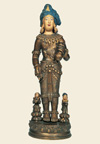
Fig. 8.31I suspect that the bronze version (Fig. 8.30) is a copy of Figure 8.24 and is later than the ivory and is either the production of a Chöying Dorjé atelier in Yunnan or perhaps even a later copy of the original ivory. Another bronze (Fig. 8.31), which we will examine below, likely stands in the same relation to the other—standing—ivory Avalokiteśvara (Fig. 8.25), which it mimics in much the same way. Whether these bronze copies were made by Chöying Dorjé himself, by an atelier under his direction, or by a later copyist is uncertain, but my feeling is that these are the work of a later copyist.
Did the Tenth Karmapa have an atelier or ateliers during his career as a sculptor and painter? There is evidence that he did employ groups of artisans. As head of the Karma Kagyü order, Chöying Dorjé exercised the patronage of that office in artistic endeavors from time to time, most notably when he called on Nepalese artists to spend three years building a seven-story, silver reliquary for his teacher the Sixth Shamar's relics in Tsurphu, in 1630, when he was twenty-six years old.[750Mengele forthcoming, 165.] Von Schroeder cites an unpublished biography with accounts of two instances when the Karmapa set up workshops:
The Karmapa founded workshops (las grwa) and collaborated with other craftsmen at different places during his travels: in 1637 he went to Gamamo (dGa' ma mo), and while there he founded a workshop with ten craftsmen.[751Von Schroeder 2001), 800-801, n. 670.] At rTselhagang, he painted the wonderful images of the sixteen arhats there and, with the help of ten craftsmen, created a pair of pillar banners (ka rgyan) with the eight auspicious signs, etc., carvings of the twelve offering goddesses on flat panels of bone, and so forth.[752Von Schroeder 2001, 801, n. 671.]
These references do not imply an atelier in the sense of standardized image production or reproduction of the Karmapa's own work, which we might not associate with this reclusive hierarch. Perhaps further discoveries in the biographies of Chöying Dorjé will shed some more light on this possibility.
In the case of the ivory standing Avalokiteśvara (Fig. 8.25) and a nearly identical bronze standing Avalokiteśvara (Fig. 8.31), von Schroeder writes (referring to the bronze version), "The Potala palace Avalokiteśvara was probably influenced by the enigmatic image incorporating aspects of Vajrapani, Kubera, and possibly Hayagriva."[753Von Schroeder 2001, 812.] (Fig. 8.2). Elsewhere, von Schroeder wrote that Chöying Dorjé, "was responsible for the manufacture of two other very similar Avalokiteśvara statues distinguished by the same particular style... . These two Avalokiteśvara statues, one cast in brass and the other carved in ivory, were likely inspired by another Yarlung period copper statue."[754Von Schroeder 2001, 800.] Thus, von Schroeder sees Figure 8.2 as the ancient inspiration and Figures 8.25 and 8.31 as the Chöying Dorjé creations based on Figure 8.2.
Here the situation is less transparent than in the previous example, because Figures 8.25 and 8.31 cannot be clearly said to be so close in visual impact to Figure 8.2 for us to assume they were directly modeled after it. Figure 8.2 is inscribed with an attribution to Chöying Dorjé while Figures 8.25 and 8.31 are not inscribed. And again, the earlier sculpture (Fig. 8.2) is "enigmatic" and "unprecedented," while the later two (Figs. 8.25 and 8.31), are meant to represent Avalokiteśvara despite the oddities, again because of the telltale antelope skin, known as a specific marker of Avalokiteśvara.
I believe these three sculptures stand in relation to each other much as the previous three do. Figure 8.2 is a visionary work of the young Tenth Karmapa. The ivory, Figure 8.25 (like Figure 8.24, which was made at the same time, when the artist was fifty-four), is a later version by the Karmapa of one of his earlier sculptures, though I suspect that the model in this case may not have been Figure 8.2 but another Chöying Dorjé sculpture we have not yet encountered. The bronze version (Fig. 8.31), so close to the ivory, is either a later Chöying Dorjé atelier production or a later copy of the ivory. The relatively late, almost modern appearance of the base in the bronze, so different from the presumed original (Fig. 8.2), would tend to indicate it is a later copy.
Later Copies
As his enigmatic style is so unique, an attribution appears to be fairly easy. Nevertheless, not all statues and paintings rendered in the style of Chöying Dorjé are necessarily his personal work. Therefore, caution is recommended, because his works were and still are enthusiastically copied.—Ulrich von Schroeder [755Ulrich and Heidi von Schroeder 2009, 48; see also von Schroeder 2008, 114.]
Above we have briefly examined two sculptures (Figs. 8.30 and 8.31) that may have been the production of an atelier run by Chöying Dorjé or under his general direction, or they may be later copies. That there was and perhaps still is a tradition of copying works by Chöying Dorjé is demonstrated by numerous other sculptures that exhibit characteristics of the work of Chöying Dorjé but seem more likely to be copies of his work made later. Usually, these copies make up a group of nearly identical sculptures.
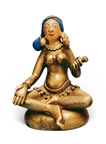 Fig. 8.32 |
 Fig. 8.33 |
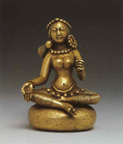 Fig. 8.34 |
One group of four sculptures of the same theme has been centered on the diminutive seated female figure now in Mindröling Monastery that was assigned a Yarlung date and provenance by von Schroeder (Fig. 8.8), who identifies two of the other three similar sculptures as copies by Chöying Dorjé of the Mindröling original.[756Von Schroeder 2001, 818.] These two sculptures are found in the same Lhakhang in Potala Palace (Figs. 8.32 and 8.33)[757Von Schroeder 2001, 818-819, pls. 194 A-D.; Shengfang Lianhua, Yixi, Wenwu Chubanshe, Beijing, 2009, p. 17; Fig. 8.33 was also published in Phontso Tsetan et. al, ed. The Origin of the Workmanship of Precious Statues in Tibet, China: China Travel and Tourism Press (2006 (Tibetan- Chinese edition) and 2007 (Tibetan-English edition).] and yet another— considerably smaller but otherwise very similar—in the Berti Aschmann Collection in the Reitberg Museum in Zurich, (Fig. 8.34)[758Helmut Uhlig 1995, On the Path to Enlightenment: The Berti Aschmann Foundation of Tibetan Art at the Museum Rietberg Zurich (Zurich: Museum Rietberg),141, pl. 88, "Seated Goddess", Tibet, 13/14th c. David Weldon identifies the figure as "Female Deity, Tibet, no date proposed": Weldon 2000, p.30, Fig. 25.] for a total of four very similar statues.
Certainly these figures feature many of the classic Chöying Dorjé idiosyncrasies, above all his treatment of face, hair, and hands as well as the simple dome base of the three brass versions; these are combined with many of his favorite Kashmir and Swat characteristics, well described by David Weldon in an important early article on foreign styles in Tibetan sculpture, where he discusses Fig. 8.34.[759Weldon 2000, pp 47- 56, fig 21 (our fig 8.34). In this perceptive early survey, Weldon recognizes the clear relationship between three Chöying Dorjé style sculptures, Figs. 28, 21 and 27 (Our Figs. 8.6, 8.34 and 8.37), and clearly sets out some of the important Kashmiri and Swat influences shared by these sculptures.] All four are so close in overall design that we are drawn to the conclusion that all were made about the same time. I do not believe that the Mindroling sculpture is Yarlung period as suggested by von Schroeder; but how then to account for this group?
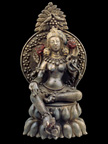
Fig. 8.35When confronting this group of four, we must ask, is one the original by Chöying Dorjé, and the others copies? Are all copies of an unknown original? Or, are some or all of these the output of a Chöying Dorjé atelier, which produced these images for his many followers? If the first option were to be our inclination, the role of the Chöying Dorjé original would go to the single copper image from Mindroling (Fig. 8.8), similar in that respect to the other inscribed sculptures cataloged as Yarlung-period sculptures by von Schroeder.[760It is worth noting that the Mindröling version (Fig. 8.8) differs from the other three not only in the metal (copper in the case of the Mindröling example, bronze/brass for the others) but also in the missing base and the addition of anklets in the case of the Mindröling version. See von Schroeder, 2001, 761, pl. 178A-C.]
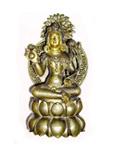
Fig. 8.36Three seated figures of Tārā in a brassy bronze, two of which come from Tibetan monastic collections, which von Schroeder classifies as the work of Chöying Dorjé [761Von Schroeder 2001, 817, 193A-D: 193C, Tārā; brass cast in three parts, 20 cm. Mindröling: Lima Lhakhang, and 193A, Tārā; brass cast in three parts, 20.1 cm. Potala Collection: Sasum Lhakhang inventory no 1445.] and the other, very similar one, now in the collection of the Rubin Museum of Art (Fig. 8.35), seem to clearly be the work of the same workshop or artist. They have clear Chöying Dorjé stylistic characteristics: elongated faces, extravagant hairdos, and the Kashmiri-style dress and jewelry from one of his stylistic phases. Does this imply that Chöying Dorjé actually produced multiples of some of his objects, and that these are products of his atelier? Or, are these the work of later pious copyists, responding to an increased demand for copies of the Karmapa's sculptures? If the latter is the case, then we can certainly imagine that the same workshop was responsible for a very similar image of Avalokiteśvara with many similar characteristics (Fig. 8.36).[762Previously published in von Schroeder 2001, 797, fig. XII-18.] The odd, round back plates with a repeated motif of a five- or six-boss pattern found on all four of these images is remarkable and not found elsewhere in the works we associate with Chöying Dorjé. But the surmounted pairs of birds in a leaf bower are practically identical to the same treatment found in other sculptures (Figs. 8.19-21 and 8.30), as well as in several paintings.
Are these sculptures the work of Chöying Dorjé, of his atelier, or are they all later copies of another original sculpture by Chöying Dorjé? I suspect the last, but at this point the answer is not entirely clear. Analysis of these several multiple versions challenges our ability to tell original from copy and to define and date the layers of reproduction in the work of Chöying Dorjé and his ateliers and copyists. However, with the next group we will examine, we seem to be presented with clear evidence that, as von Schroeder asserted, Chöying Dorjé's "works were and still are enthusiastically copied."[763Ulrich and Heidi von Schroeder 2009, 48; see also von Schroeder 2008, 114.]
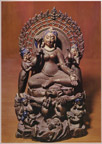
Fig. 8.37The silver Sarasvatī now in Potala Palace, with her extravagant retinue (Fig. 8.6), has spawned a veritable crowd of copies. Perhaps the best known is the copper-alloy version preserved in Rumtek Monastery in Sikkim, the home in exile of the Sixteenth Karmapa after he fled Tibet (Fig. 8.37). The Rumtek version is clearly based on the silver sculpture in the Potala collection. But whereas the silver sculpture exhibits the odd, elongated-oval face with small mouth and arched eyebrows of Chöying Dorjé, the face of the Rumtek sculpture has been noticeably "normalized" into a pleasing feminine visage, and the hands are no longer the plump mitts of the earlier sculptures and the paintings. This surely must be a somewhat later copy of the silver original now in the Potala. Von Schroeder identifies it as the work of Chöying Dorjé himself, a copy of what he considers the Yarlung original. But if we understand the silver sculpture in the Potala to be a work of Chöying Dorjé, then the Rumtek version must either be a later adaptation by Chöying Dorjé himself or the work of an atelier under his direction or an altogether later copy.
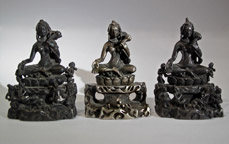
Fig. 8.38a-cThe silver original, or the Rumtek copy, has also been copied, up to the present day perhaps, in numerous reproductions. Here we show eight examples from various collections (Figs. 8.38-43). These are all tiny, about 2 3⁄8 inches (6 cm) in height, and appear to be made from a brass alloy of some kind, save one, which appears to use a silver alloy (Fig. 8.38b). Extraordinarily detailed, these miniature sculptures are often also made of several pieces.
In the one in the Alsop Collection (Fig. 8.43), the main figure is separate from the base, as are two of the smaller figures on its base, and similar multiple separate figures are found in some of the others. There are several noticeable differences between these miniatures and the silver Sarasvatī in the Potala and the Rumtek copy: the miniatures omit the two birds on the base and replace the standing attendants holding vases with kneeling figures. The retinue of figures varies among this group of miniatures. Seven examples have the six attendant figures of the original, two at the top of the base and four below; the Chen version (Fig. 8.39) omits the two on the top and has only three below, while Figure 8.38a eliminates the attendants altogether. Several are sealed, some are not.
 Fig. 8.39 |
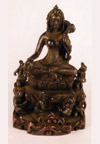 Fig. 8.40 |
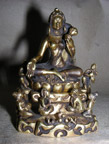 Fig. 8.41 |
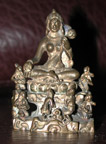 Fig. 8.42 |
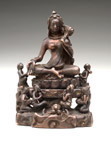 Fig. 8.43 |
While several of these miniature sculptures exhibit a certain amount of patination, tool marks are easily visible on others, and it would appear that these are all of relatively modern date. The fine casting suggests the use of modern miniature casting techniques, resembling in some respects modern Buddhist amulets in metal from Thailand.
In this case, the visual evidence is quite clear. The original silver image, now in the Potala, shows many of the characteristics of the work of the Tenth Karmapa, most noticeably the ovoid face and arched eyebrows. This distinctive face has been changed and regularized in the Rumtek image and then in the numerous tiny modern amulet copies.
Who made these miniature copies? Where were they made, and why? I imagine that at some point we may have answers to these questions, but for now they remain among the many unsolved mysteries surrounding the work of Chöying Dorjé.[764It may be of more than anecdotal interest that the majority of these miniatures have come out of China or are still there. Hon Lau of Hollywood Galleries pointed this out me in reference to the three examples in his own collection (Figs. 8.38AC). Two of the others are in the hands of Tibetan collectors in Chengdu, while another two are in the collections of Chinese collectors or dealers outside of China. I bought our example in the antiquity market (curio city) in Beijing several years ago. This might suggest they were manufactured in China.]
Works Traditionally Attributed to Chöying Dorjé:
There are quite a few sculptures stored in the Karma Kagyü seat of Tsurphu in Tibet or later in Rumtek in Sikkim known by tradition as works of Chöying Dorjé. We have already examined one sculpture that is now kept in Rumtek in Sikkim, where the Sixteenth Karmapa established his seat in exile (Fig. 8.37).[765Madanjeet Singh 1971, Himalayan Art: Wall- Painting and Sculpture in Ladakh, Lahaul and Spiti, the Siwalik Ranges, Nepal, Sikkim and Bhutan. (New York: MacMillan, 1971): 20; Nik Douglas and Meryl White 1976, Karmapa: The Black Hat Lama of Tibet. (London: Luzacs, 1976): 133, (no. 48). In Mengele forthcoming, this sculpture is perhaps listed as no. 44 in the list of sculptures (p.388) . Mengele forthcoming, 388, also cites two other objects cited by Douglas and White, her nos. 43 & 45. It is unclear if the Douglas and White list is from a written inventory alone or a visual inspection as well.] In many cases of works attributed to a famous lama or artist the attributions may appear apocryphal and mythical but in other cases old attributions may have merit. In any case, it is worth noting a few of the sculptures that have been passed down in the Karmapa tradition as the work of the Tenth Karmapa.
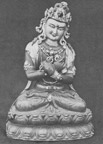 Fig. 8.44 |
 Fig. 8.45 |
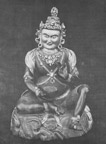 Fig. 8.46 |
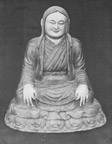 Fig. 8.47 |
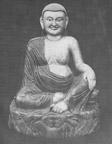 Fig. 8.48 |
Perhaps most prominent among the small group for which we have photographs, is a group of sculptures in rhinocerous horn depicting the Karma Kagyü lineage from the adibuddha Vajradhāra (Dorjé Chang), the adepts Tilopa and Nāropa, Marpa the translator and Milarepa (Figs. 8.44-48), previously in Tsurphu monastery and now in Rumtek.[766Previously published in Nik Douglas and Meryl White 1976, Karmapa: The Black Hat Lama of Tibet. (London: Luzacs, 1976), pp. 2-18. Mengele forthcoming, 388, lists 3 further rhinoceros horn carvings (her nos. 46-48) from Rin-chen-dpal- bzang's 1995 account, 73.16-19.] The attribution to the Tenth Karmapa is mentioned in a 1976 Western history of the Karmapa lineage, while a reminiscence by Hugh Richardson of visits to Tsurphu in 1946 and 1950 appears to refer to one of the sculptures illustrated in that same history.[767Douglas and White 1976, 2-18; Hugh E. Richardson 1998, "Memories of Tsurphu" in High Peaks, Pure Earth: Collected Writings on Tibetan History and Culture. (London/Chicago: Serindia, 1998): 732, remembers a "sturdy figure (of Milarepa) carved in rhinoceros horn by a previous incarnation."] The material is rare and exotic, (perhaps evidence of the involvement of a high lama or other donor of means) but the sculptures themselves are in an unexceptional style of the seventeenth to eighteenth century without any of the whimsical characteristics or Kashmiri mannerisms seen in his work, and thus the attributions to Chöying Dorjé have been considered apocryphal.[768Von Schroeder 2011, p. 801 n677, "When compared with his other known sculptures, the five rhinoceros tusk carvings share little stylistic features with the ones cast in metal or carved from ivory and wood." Also Mengele forthcoming, 365-367.]
Numerous other sculptures attributed to the Tenth Karmapa found in Tsurphu or Rumtek are enumerated in two modern accounts of the modern Karma Kagyü tradition, but few have been examined and studied, and photographs are also rare.[769See Mengele forthcoming, p.388-389: her list of sculptures, nos. 43- 54, all of which are citations from Douglas and White 1976 or Rin chen dpal bzang 1995 who was drawing on memories of the years he spent serving the 16th Karmapa as a young lama in Tsurphu before he fled Tibet and settled in Rumtek.]

Fig. 8.49Just as this volume was going to press, we were introduced to yet another inscribed sculpture by Chöying Dorjé (Fig. 8.49). It is an important sculpture and thus worth a last minute look, although a detailed analysis will have to wait for later, in an on-line version of this article to appear in asianart.com and in other discussions. The sculpture, cast in brass and still embellished with traces of cold-gold paint, depicts a figure seated in a relaxed pose (reminiscent of Fig. 8.4) on a throne, holding the bud of a flower in his left hand at his knee, with his right hand before his chest in an indeterminate open gesture. The antelope skin draped over his left shoulder assures us that Avalokiteśvara is intended, as does the explicit inscription, "icon of spyan ras gzigs (Avalokiteśvara) by the hand of Gyalwang Chöying Dorjé." Various of the mannerisms of Chöying Dorjé can be found here, including the high pony-tail hair style, the fleshy face, and the bird (single in this case) in the bower at the top of the mandorla. Clear references to the Kashmiri style so beloved of Chöying Dorjé include the striated dhoti and the mountainous hourglass-shaped support to the throne (compare Fig. 8.26) with donor figures—themselves worthy of close examination—and intertwined nagas. The sculpture is unusual in the Tenth Karmapa's oeuvre both in the wording of the inscription and also as the first sculpture in cast brass with an inscription to come to our notice. This figure invites further analysis, and reminds us of what we have yet to learn.
Conclusion
Establishing a chronology and a meaningful inventory of the sculptures of Chöying Dorjé is a daunting task. There is considerable confusion and disagreement regarding who made what, and when. The six extraordinary sculptures we examined at the very beginning of this essay (Fig. 8.1-6), are believed by Ulrich von Schroeder to be ancient works of artists from the seventh to eighth century which then served as models Chöying Dorjé copies: I believe they are the works of this master himself, probably created at a young age, and perhaps with the help of Nepalese artisans. In the case of some other sculptures, we agree that they should be included among the Tenth Karmapa's works, (Figs. 8.20-25). And in assessing yet another group, von Schroeder is sure of a Chöying Dorjé attribution whereas I feel they are more likely the work of later copyists (Figs. 8.30, 8.31, 8.32, and 8.33 as well as the two sculptures in Tibet closely resembling Fig. 8.35). In assessing some other works (Figs. 8.44-48) we share skepticism even though Tibetan tradition assigns them to the Tenth Karmapa.
I thank the reader for spending such a long time with me on this remarkable and disparate group of sculptures. We leave this group with many questions unanswered. Several of the biographical sources mentions works by this prolific artist that we cannot now identify but which may appear before us in the future, and it is to be hoped that further evidence will come to light, in the form of historical literature or other sculptures by or influenced by Chöying Dorjé. We have much to learn.
The correct definition of the beginnings of the Tibetan Buddhist sculptural tradition, and an accurate appreciation of the work of the Tenth Karmapa are both of paramount importance to our study of the art of Buddhist Tibet. I hope the present interpretation of these unusual sculptures contributes to that understanding, or at least contributes toward a lively conversation on both subjects.


